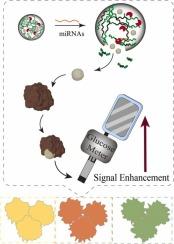Stimuli-responsive DNA hydrogels releasing nucleoside carbon dots to enhance enzyme activity for cancer subtype discrimination
IF 3.7
1区 化学
Q1 CHEMISTRY, ANALYTICAL
引用次数: 0
Abstract
Signal probe leakage poses a significant challenge in signal amplification methods for DNA hydrogel-based electrochemical biosensors. To address this issue, we developed a dual-trigger DNA hydrogel utilizing the i-motif structure, which not only ensures rapid response times (within 5 min) but also maintains the prolonged stability of the encapsulated signal probes (up to 120 h). To further enhance stability, we constructed a catalytic system where adenosine carbon dots (ACDs) modulate glucose dehydrogenase activity and functionalized as signal probes. We established detection pathways for three miRNAs and explored the relationship between analyte concentration and the biosensor's capability to discriminate among three types of exosomes. The results demonstrate that the combination of miRNA-21 and miRNA-122 achieved superior classification performance, with a balanced classification effect for exosomes across various concentrations (83.33 %). This study presents new opportunities for the design of stable electrochemical biosensors and provides valuable insights of multi-target detection to improve the analytical accuracy.

释放核苷碳点的刺激反应性DNA水凝胶增强癌症亚型识别酶活性
信号探针泄漏对DNA水凝胶电化学生物传感器的信号放大方法提出了重大挑战。为了解决这个问题,我们开发了一种利用i-motif结构的双触发DNA水凝胶,不仅确保了快速响应时间(5分钟内),而且保持了封装信号探针的长时间稳定性(长达120小时)。为了进一步提高稳定性,我们构建了一个由腺苷碳点(ACDs)调节葡萄糖脱氢酶活性并作为信号探针的催化体系。我们建立了三种mirna的检测途径,并探索了分析物浓度与生物传感器区分三种类型外泌体的能力之间的关系。结果表明,miRNA-21和miRNA-122的组合具有较好的分类性能,对不同浓度外泌体的分类效果均衡(83.33%)。该研究为设计稳定的电化学生物传感器提供了新的机会,并为多靶点检测提高分析精度提供了有价值的见解。
本文章由计算机程序翻译,如有差异,请以英文原文为准。
求助全文
约1分钟内获得全文
求助全文
来源期刊

Sensors and Actuators B: Chemical
工程技术-电化学
CiteScore
14.60
自引率
11.90%
发文量
1776
审稿时长
3.2 months
期刊介绍:
Sensors & Actuators, B: Chemical is an international journal focused on the research and development of chemical transducers. It covers chemical sensors and biosensors, chemical actuators, and analytical microsystems. The journal is interdisciplinary, aiming to publish original works showcasing substantial advancements beyond the current state of the art in these fields, with practical applicability to solving meaningful analytical problems. Review articles are accepted by invitation from an Editor of the journal.
 求助内容:
求助内容: 应助结果提醒方式:
应助结果提醒方式:


